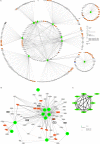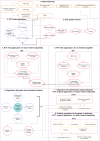Genetic regulators of mineral amount in Nelore cattle muscle predicted by a new co-expression and regulatory impact factor approach
- PMID: 32439843
- PMCID: PMC7242321
- DOI: 10.1038/s41598-020-65454-7
Genetic regulators of mineral amount in Nelore cattle muscle predicted by a new co-expression and regulatory impact factor approach
Abstract
Mineral contents in bovine muscle can affect meat quality, growth, health, and reproductive traits. To better understand the genetic basis of this phenotype in Nelore (Bos indicus) cattle, we analysed genome-wide mRNA and miRNA expression data from 114 muscle samples. The analysis implemented a new application for two complementary algorithms: the partial correlation and information theory (PCIT) and the regulatory impact factor (RIF), in which we included the estimated genomic breeding values (GEBVs) for the phenotypes additionally to the expression levels, originally proposed for these methods. We used PCIT to determine putative regulatory relationships based on significant associations between gene expression and GEBVs for each mineral amount. Then, RIF was adopted to determine the regulatory impact of genes and miRNAs expression over the GEBVs for the mineral amounts. We also investigated over-represented pathways, as well as pieces of evidences from previous studies carried in the same population and in the literature, to determine regulatory genes for the mineral amounts. For example, NOX1 expression level was positively correlated to Zinc and has been described as Zinc-regulated in humans. Based on our approach, we were able to identify genes, miRNAs and pathways not yet described as underlying mineral amount. The results support the hypothesis that extracellular matrix interactions are the core regulator of mineral amount in muscle cells. Putative regulators described here add information to this hypothesis, expanding the knowledge on molecular relationships between gene expression and minerals.
Conflict of interest statement
The authors declare no competing interests.
Figures





References
-
- Geesink GH, Koohmaraie M. Effect of Calpastatin on Degradation of Myofibrillar Proteins by µ -Calpain Under Postmortem Conditions. J. Anim. Sci. 1999;77:2685–2692. - PubMed
-
- Williams P. Nutritional composition of red meat. Nutr. Diet. 2007;64:5–7.
-
- Doyle JJ, Spaulding JE. Toxic and Essential Trace Elements in Meat - a Review. J. Anim. Sci. 1978;47:398–419. - PubMed
-
- Campbell I. Macronutrients, minerals, vitamins and energy. Anaesth. Intensive Care Med. 2017;18:141–146.
-
- Jalali S, et al. Effect of copper, zinc, and manganese supplementation and source on reproduction, mineral status, and performance in grazing beef cattle over a two-year period. J. Anim. Sci. 2017;95:47–47. - PubMed
Publication types
MeSH terms
Substances
LinkOut - more resources
Full Text Sources
Medical

